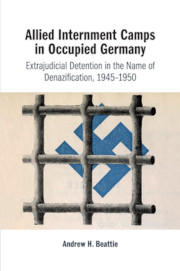 Allied Internment Camps in Occupied Germany
Allied Internment Camps in Occupied Germany Book contents
- Allied Internment Camps in Occupied Germany
- Allied Internment Camps in Occupied Germany
- Copyright page
- Dedication
- Contents
- Illustrations
- Acknowledgements
- Abbreviations
- Introduction
- 1 ‘It Will Be Desirable on Political Grounds’
- 2 ‘Not Consistent with Civil Liberties’
- 3 Internees
- 4 Internment Camps
- Conclusion
- Glossary of German Terms
- Bibliography
- Index
1 - ‘It Will Be Desirable on Political Grounds’
The Development of Internment Policy, 1943–1946
Published online by Cambridge University Press: 28 October 2019
- Allied Internment Camps in Occupied Germany
- Allied Internment Camps in Occupied Germany
- Copyright page
- Dedication
- Contents
- Illustrations
- Acknowledgements
- Abbreviations
- Introduction
- 1 ‘It Will Be Desirable on Political Grounds’
- 2 ‘Not Consistent with Civil Liberties’
- 3 Internees
- 4 Internment Camps
- Conclusion
- Glossary of German Terms
- Bibliography
- Index
Summary
Chapter 1 traces the development of Allied internment policy from 1943 to 1946. It examines the discussions and statements of the UK, USA, and USSR, including at their European Advisory Committee and in the Potsdam Agreement of 1945. It analyses arrest directives issued in 1944–5 by western military authorities and the Soviet NKVD and discusses the Allied Control Authority’s attempt to develop a detailed quadripartite policy in late 1945/early 1946. It shows that the British were more enthusiastic and that the ‘Morgenthau Plan’ was less significant for US policy than is generally believed. The chapter argues that security, punishment, political change, and reparatory labour all featured in Allied thinking and that internment was consistently conceived as an extrajudicial measure against targets defined largely by their positions in Nazi organizations, rather than by individual acts. The chapter identifies differences over the precise targets, with Soviet directives being more expansive than their western equivalents and calling for members of the SA, SS and other paramilitary organizations to be deported as POWs rather than interned in Germany. Comparisons with Austria reveal basic similarities for the western powers but a different Soviet approach of leaving denazification and internment to Austria’s provisional government.
Keywords
- Type
- Chapter
- Information
- Allied Internment Camps in Occupied GermanyExtrajudicial Detention in the Name of Denazification, 1945–1950, pp. 25 - 59Publisher: Cambridge University PressPrint publication year: 2019
